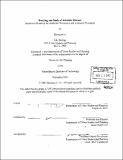| dc.contributor.advisor | Eric Klopfer. | en_US |
| dc.contributor.author | Lo, Monique (Monique Chun-Ying), 1978- | en_US |
| dc.contributor.other | Massachusetts Institute of Technology. Dept. of Urban Studies and Planning. | en_US |
| dc.date.accessioned | 2012-01-12T19:22:32Z | |
| dc.date.available | 2012-01-12T19:22:32Z | |
| dc.date.copyright | 2001 | en_US |
| dc.date.issued | 2001 | en_US |
| dc.identifier.uri | http://hdl.handle.net/1721.1/68377 | |
| dc.description | Thesis (M.C.P.)--Massachusetts Institute of Technology, Dept. of Urban Studies and Planning, 2001. | en_US |
| dc.description | Includes bibliographical references (leaf 46). | en_US |
| dc.description.abstract | Antibiotic-resistant bacteria pose a serious threat to immuno-compromised individuals in Intensive Care Units (ICU). This study examines several cycling treatments (7,14,30,60,120,240-day cycle) and random fraction treatment (50-50,60-40,80-20,100-0) strategies in ICU and finds that no single strategy will outperform all others. Human, hospital and pathogen conditions such as admission/departure rate, transmission rate, drug application rate, and incoming patients' characteristics influence the selection of the optimal treatment strategy. Random fraction treatment is generally favored when admission/departure rate is large. Cycling treatment is generally favored when admission/departure rate is small. When transmission rates are high, longer cycle period are preferred. When transmission rates are low, random fraction treatments are preferred. For cycling treatments, longer cycle periods is associated with lower drug application rates whereas shorter cycle periods are associated with larger drug application rates.Antibiotic-resistant bacteria pose a serious threat to immuno-compromised individuals in Intensive Care Units (ICU). This study examines several cycling treatments (7,14,30,60,120,240-day cycle) and random fraction treatment (50-50,60-40,80-20,100-0) strategies in ICU and finds that no single strategy will outperform all others. Human, hospital and pathogen conditions such as admission/departure rate, transmission rate, drug application rate, and incoming patients' characteristics influence the selection of the optimal treatment strategy. Random fraction treatment is generally favored when admission/departure rate is large. Cycling treatment is generally favored when admission/departure rate is small. When transmission rates are high, longer cycle period are preferred. When transmission rates are low, random fraction treatments are preferred. For cycling treatments, longer cycle periods is associated with lower drug application rates whereas shorter cycle periods are associated with larger drug application rates. | en_US |
| dc.description.statementofresponsibility | by Monique Lo. | en_US |
| dc.format.extent | 54 leaves | en_US |
| dc.language.iso | eng | en_US |
| dc.publisher | Massachusetts Institute of Technology | en_US |
| dc.rights | M.I.T. theses are protected by
copyright. They may be viewed from this source for any purpose, but
reproduction or distribution in any format is prohibited without written
permission. See provided URL for inquiries about permission. | en_US |
| dc.rights.uri | http://dspace.mit.edu/handle/1721.1/7582 | en_US |
| dc.subject | Urban Studies and Planning. | en_US |
| dc.title | Modeling and study of infectious disease : stochastic modeling for antibiotic resistance and treatment strategies | en_US |
| dc.type | Thesis | en_US |
| dc.description.degree | M.C.P. | en_US |
| dc.contributor.department | Massachusetts Institute of Technology. Department of Urban Studies and Planning | |
| dc.identifier.oclc | 50336422 | en_US |
